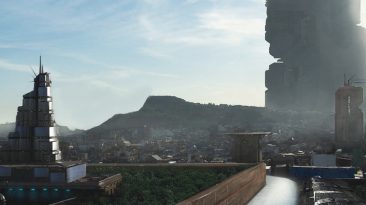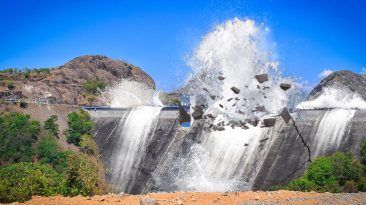For decades, relations between America and North Korea have run from tense highs to some interesting lows. But what happens when two superpowers decide that enough is enough?
With more destructive nuclear technology available now than ever before, the scope of this war could almost be biblical. Well, those old “duck and cover” drills are useless now. So what if North Korea Tsunami-bombed America?
Where would the bomb be detonated? How much time would you have to evacuate people? And would the fallout be worse than the tsunami?
In 2018, Russia announced the creation of a self-proclaimed doomsday machine, the Poseidon. This 50-megaton nuclear bomb is designed to trigger a tsunami after being detonated under an ocean’s surface.
Even New Zealand tried to weaponize nature, back in 1944, with Project Seal. Using a series of nuclear blasts, they created a 10 m (33 ft) tsunami wave. But now, if North Korea tried to tsunami-bomb America, how strong would the blast have to be?
So far, there has only been one attack, by one nation against another, using nuclear weapons. But if this long-standing rivalry were to go nuclear, all bets would be off. Unlike the World War II attacks on Hiroshima and Nagasaki, if North Korea instigated nuclear war, their bomb wouldn’t drop from a plane.
Chances are, North Korea would use a submarine for a sneak attack. And now they have a closer shot at reaching the coastline.
And if North Korea wanted to only set off one bomb, they would use something as destructive as The Poseidon. But it could be more likely that North Korea would trigger a series of nuclear explosions near California’s beaches. After all, some reports estimate North Korea’s nuclear stockpile is as high as 60 weapons, with some weighing around 5,000 tons.
A chain reaction of nuclear explosions in the Pacific Ocean would set off a massive tsunami that would head right for the U.S. shoreline. Due to the prevailing winds, heavily populated areas like San Francisco and Los Angeles might be the primary targets in this apocalyptic war.
If the bomb detonated close to shore, the blast would generate waves. But they wouldn’t reach the deadly speeds that cause so much destruction inland. The size of the wave would depend on how much water the bomb displaced on the ocean floor. So If the bomb, or bombs, were to explode in deep water, the tsunami could reach speeds of 805 km/h (500 mph).
And while this would be much more destructive than a bomb detonated closer to shore, it might give some people time to evacuate – around 15 minutes. If you’re still around after that, you’ll need to seek shelter from the onslaught that’s coming. After all, a tsunami isn’t one wave. It’s multiple waves coming one after another, each one carrying a little less energy. And it can last for up to two hours.
This would destroy buildings, homes, cars, and anyone in its path. A natural tsunami spreads disease, with saltwater flooding aquifers and sewage pouring over farmland and city streets.
And now, add the threat of nuclear contamination in every drop of water. You’d have a serious threat to all life, human and otherwise. It would leave the ocean sediment irradiated. Even the rain could threaten your health. And if the waves haven’t torn apart the vegetation, the nuclear fallout would poison the food supply.
So, if a tsunami-bomb attack were to hit now, how prepared are coastal cities? In the year 2011, the Fukushima nuclear disaster in Japan put the world on edge. We watched, in real time, the effects of two massive forces of nature colliding, as the power plant began melting down after a tsunami.
The United States Geological Survey simulated a tsunami starting off the coast of Alaska and hitting Los Angeles – with the same force that the 2011 tsunami hit Japan. The study showed that waves of 1-3 m (3 to 10 ft) could flood Long Beach and surrounding areas.
Depending on what time of year the attack happened, almost half a million people could need to be evacuated, and thousands would be left homeless. The damage from the tsunami alone would reach around $8 billion.
But that pales in comparison to the loss of human lives that we could expect. The death toll in Japan reached around 20,000 people. And if America were caught off guard in a tsunami-bomb attack, the loss of life and destruction could be just as devastating.
But, as chilling as this situation might be, the reality is that military strategists think that this plan is not destructive enough. To fully use a nuclear weapon’s horrific effects, it would be better to detonate it overland, not in the ocean.
Sources
- “‘Tsunami Bomb’ Created By US Military”. Marc Lallanilla. 2021. livescience.com.
- “The US And New Zealand Secretly Tested The First Tsunami Bomb”. Robert, Johnson. 2021. Business Insider.
- “Tsunamis | Manoa.Hawaii.Edu/Exploringourfluidearth”. 2021. manoa.hawaii.edu.
- “What Causes A Tsunami? – Tsunami Geology”. King, Hobart. 2021. geology.com.
- “A new Russian video may show a ‘doomsday machine’ able to trigger 300-foot tsunamis — but nuclear weapons experts question why you’d ever build one”. Dave, Mosher. 2021. Business Insider.
- “Direct Energy Estimation Of The 2011 Japan Tsunami Using Deep-Ocean Pressure Measurements”. Tang, Liujuan, Vasily V. Titov, Eddie N. Bernard, Yong Wei, Christopher D. Chamberlin, Jean C. Newman, and Harold O. Mofjeld et al. 2012. Journal Of Geophysical Research: Oceans 117 (C8): n/a-n/a. doi:10.1029/2011jc007635.
- “Strain Energy Release From The 2011 9.0 Mw Tōhoku Earthquake, Japan”. M. Cruikshank, Kenneth, and Curt D. Peterson. 2013. Open Journal Of Earthquake Research 02 (04): 75-83. doi:10.4236/ojer.2013.24008.



























